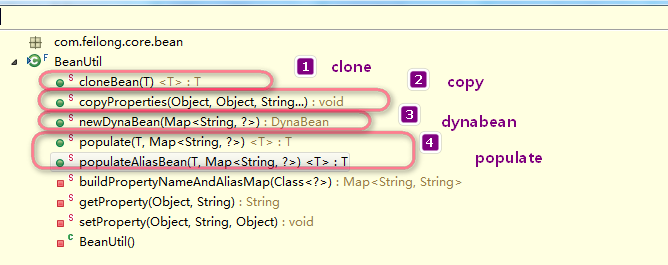BeanUtil - ifeilong/feilong GitHub Wiki
将 fromObj 中的全部或者一组属性 includePropertyNames 的值,复制到 toObj 对象中.
注意:
- 这种copy都是
浅拷贝,复制后的2个Bean的同一个属性可能拥有同一个对象的ref,在使用时要小心,特别是对于属性为自定义类的情况 . - 此方法调用了
BeanUtils.copyProperties(Object, Object),会自动进行Object--->String--->Object类型转换 - 如果指定了
includePropertyNames,会调用getProperty(Object, String),在自动进行Object--->String类型转换过程中,如果发现值是数组,只会取第一个元素重新构造数组转到 toObj中,规则参见 ConvertUtil.toString(Object) - 如果需要copy的两个对象属性之间的类型一样的话,那么调用这个方法会有性能消耗,此时强烈建议调用
PropertyUtil.copyProperties(Object, Object, String) - 不支持toObj是map类型,从
BeanUtilsBean.copyProperties(Object, Object)源码可以看出, fromObj可以是map
使用示例: 例如两个pojo: user和userForm 都含有字段"enterpriseName","linkMan","phone"
通常写法:
.....
user.setEnterpriseName(userForm.getEnterpriseName());
user.setLinkMan(userForm.getLinkMan());
user.setPhone(userForm.getPhone());
......此时,可以使用
BeanUtil.copyProperties(user,userForm,"enterpriseName","linkMan","phone");注册自定义 Converter:
如果有 java.util.Date类型的需要copy,那么需要先使用ConvertUtils.register(Converter, Class)方法:
ConvertUtils.register(new DateLocaleConverter(Locale.US, DatePattern.TO_STRING_STYLE),Date.class); BeanUtils.copyProperties(Object, Object)与 PropertyUtils.copyProperties(Object, Object)区别
-
BeanUtils.copyProperties(Object, Object)提供类型转换功能,即发现两个JavaBean的同名属性为不同类型时,在支持的数据类型范围内进行转换,而PropertyUtils.copyProperties(Object, Object)不支持这个功能,但是速度会更快一些. - commons-beanutils v1.9.0以前的版本 BeanUtils不允许对象的属性值为 null,PropertyUtils可以拷贝属性值 null的对象.
- (注:commons-beanutils v1.9.0+修复了这个情况,
BeanUtilsBean.copyProperties()no longer throws aConversionExceptionfor null properties of certain data types),具体信息,可以参阅commons-beanutils的 RELEASE-NOTES.txt
相比较直接调用 BeanUtils.copyProperties(Object, Object)的优点:
- 将 checkedException 异常转成了
BeanOperationExceptionRuntimeException,因为通常copy的时候出现了checkedException,也是普普通通记录下log,没有更好的处理方式 - 支持
includePropertyNames参数,允许针对性copy 个别属性 - 更多,更容易理解的的javadoc
调用BeanUtils.cloneBean(Object).
注意:
- 这个方法通过默认构造函数建立一个bean的新实例,然后拷贝每一个属性到这个新的bean中,即使这个bean没有实现 Cloneable接口 .
- 是为那些本身没有实现clone方法的类准备的
- 在源码上看是调用了
getPropertyUtils().copyProperties(newBean, bean);最后实际上还是复制的引用,无法实现深clone - 但还是可以帮助我们减少工作量的,假如类的属性不是基础类型的话(即自定义类),可以先clone出那个自定义类,在把他付给新的类,覆盖原来类的引用
- 如果需要深度clone,可以使用
SerializationUtils.clone,但是它的性能要慢很多倍 - 由于内部实现是通过
Class.newInstance()来构造新的对象,所以需要被clone的对象必须存在默认无参构造函数,否则会出现异常InstantiationException - 目前无法clone list,总是返回empty list,参见
BeanUtils.cloneBeanwith List is broken
把properties/map里面的值 populate (填充)到bean中.
说明:
- 将Map<Key,value>中的以值(String或String[])转换到目标bean对应的属性中,Key是目标bean的属性名.
- apache的javadoc中,明确指明这个方法是为解析http请求参数特别定义和使用的,在正常使用中不推荐使用.推荐使用
copyProperties(Object, Object, String)方法 - 底层方法原理
BeanUtilsBean.populate(Object, Map),循环map,调用BeanUtilsBean.setProperty(Object, String, Object)方法 ,一一对应设置到 bean对象 - 如果properties key中有bean中不存在的属性,那么该条数据自动忽略
- 如果properties key中有null,那么该条数据自动忽略,see
BeanUtilsBean.populate(Object, Map)line 817 - bean可以是Map类型,不会转换之后的key和value都会是Object类型,而不是声明的类型,see
BeanUtilsBean.setProperty(Object, String, Object)line 928
示例:
User user = new User();
user.setId(5L);
Map<String, Object> properties = new HashMap<>();
properties.put("id", 8L);
BeanUtil.populate(user, properties);
LOGGER.info(JsonUtil.format(user));**返回: **
{
"id": 8,
}将 alias 和value 的map populate (填充)到 aliasBean.
背景: BeanUtil 有标准的populate功能:populate(Object, Map) ,但是要求 map的key 和 bean的属性名称必须是一一对应
有很多情况,比如 map 的key是 "memcached.alivecheck" 这样的字符串(常见于properties 的配置文件),或者是大写的 "ALIVECHECK" 的字符串(常见于第三方接口 xml属性名称)
而我们的bean里面的属性名称是标准的 java bean 规范的名字,比如 "aliveCheck",这时就没有办法直接使用 populate(Object, Map) 方法了
你可以使用 populateAliasBean(Object, Map)方法~~
示例:
有以下aliasAndValueMap信息:
{
"memcached.alivecheck": "false",
"memcached.expiretime": "180",
"memcached.initconnection": "10",
"memcached.maintSleep": "30",
"memcached.maxconnection": "250",
"memcached.minconnection": "5",
"memcached.nagle": "false",
"memcached.poolname": "sidsock2",
"memcached.serverlist": "172.20.31.23:11211,172.20.31.22:11211",
"memcached.serverweight": "2",
"memcached.socketto": "3000"
}有以下aliasBean信息:
public class DangaMemCachedConfig{
//** The serverlist.
@Alias(name = "memcached.serverlist",sampleValue = "172.20.31.23:11211,172.20.31.22:11211")
private String[] serverList;
//@Alias(name = "memcached.poolname",sampleValue = "sidsock2")
private String poolName;
//** The expire time 单位分钟.
@Alias(name = "memcached.expiretime",sampleValue = "180")
private Integer expireTime;
//** 权重.
@Alias(name = "memcached.serverweight",sampleValue = "2,1")
private Integer[] weight;
//** The init connection.
@Alias(name = "memcached.initconnection",sampleValue = "10")
private Integer initConnection;
//** The min connection.
@Alias(name = "memcached.minconnection",sampleValue = "5")
private Integer minConnection;
//** The max connection.
@Alias(name = "memcached.maxconnection",sampleValue = "250")
private Integer maxConnection;
//** 设置主线程睡眠时间,每30秒苏醒一次,维持连接池大小.
@Alias(name = "memcached.maintSleep",sampleValue = "30")
private Integer maintSleep;
//** 关闭套接字缓存.
@Alias(name = "memcached.nagle",sampleValue = "false")
private Boolean nagle;
//** 连接建立后的超时时间.
@Alias(name = "memcached.socketto",sampleValue = "3000")
private Integer socketTo;
//** The alive check.
@Alias(name = "memcached.alivecheck",sampleValue = "false")
private Boolean aliveCheck;
//setter getter 略
}此时你可以如此调用代码:
Map<String, String> readPropertiesToMap = ResourceBundleUtil.readPropertiesToMap("memcached");
DangaMemCachedConfig dangaMemCachedConfig = new DangaMemCachedConfig();
BeanUtil.populateAliasBean(dangaMemCachedConfig, readPropertiesToMap);
LOGGER.debug(JsonUtil.format(dangaMemCachedConfig));**返回: **
{
"maxConnection": 250,
"expireTime": 180,
"serverList": [
"172.20.31.23",
"11211",
"172.20.31.22",
"11211"
],
"weight": [2],
"nagle": false,
"initConnection": 10,
"aliveCheck": false,
"poolName": "sidsock2",
"maintSleep": 30,
"socketTo": 3000,
"minConnection": 5
}此时你会发现,上面的 serverList 期望值是 ["172.20.31.23:11211","172.20.31.22:11211"],但是和你的期望值不符合,
因为, ArrayConverter 默认允许的字符 allowedChars 只有 '.', '-',其他都会被做成分隔符
你需要如此这般:
Map<String, String> readPropertiesToMap = ResourceBundleUtil.readPropertiesToMap("memcached");
DangaMemCachedConfig dangaMemCachedConfig = new DangaMemCachedConfig();
ArrayConverter arrayConverter = new ArrayConverter(String[].class, new StringConverter(), 2);
char[] allowedChars = { ':' };
arrayConverter.setAllowedChars(allowedChars);
BeanUtil.register(arrayConverter, String[].class);
BeanUtil.populateAliasBean(dangaMemCachedConfig, readPropertiesToMap);
LOGGER.debug(JsonUtil.format(dangaMemCachedConfig));**返回: **
{
"maxConnection": 250,
"expireTime": 180,
"serverList": [
"172.20.31.23:11211",
"172.20.31.22:11211"
],
"weight": [2],
"nagle": false,
"initConnection": 10,
"aliveCheck": false,
"poolName": "sidsock2",
"maintSleep": 30,
"socketTo": 3000,
"minConnection": 5
}使用 valueMap 来构造一个 DynaBean.
说明:
- 一般情况下,你可能不需要使用这个方法
- 很适合那种属性值数量不确定,并且又不想在页面使用map来渲染的地方,比如制作多维度的图表
- 程序内部,默认使用的是
org.apache.commons.beanutils.LazyDynaClass - 不需要先创建一个期望的数据结构DynaClass,就能向LazyDynaBean中填充我们任意想填充的数据。
-
LazyDynaBean内部会根据我们填充进的数据(即使是一个map中的一个key-value pair),创建metadata的。
示例:
DynaBean newDynaBean = BeanUtil.newDynaBean(toMap(//
Pair.of("address", (Object) new HashMap()),
Pair.of("firstName", (Object) "Fred"),
Pair.of("lastName", (Object) "Flintstone")));
LOGGER.debug(JsonUtil.format(newDynaBean));**返回: **
{
"address": {},
"firstName": "Fred",
"lastName": "Flintstone"
}

